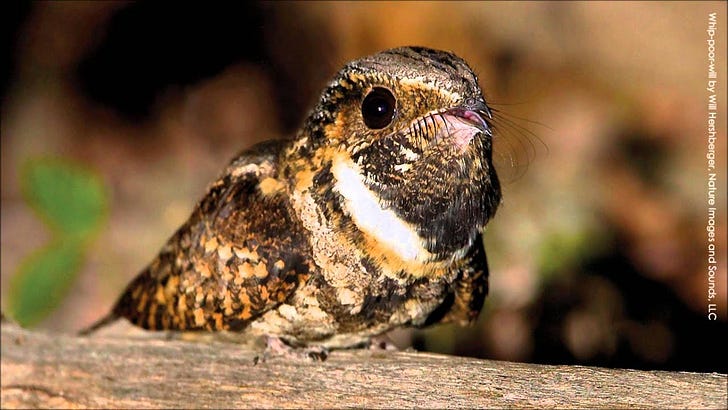Whip, Don't Fire at Will!
Today’s special animal friend is the Eastern whip-poor-will, Antrostomus vociferus. Native to Eastern North America, this bird is found around National Forest campgrounds, where it is not as loud as drunk Clemson alumni. However, it carries on until dawn, pausing only to take a deep breath, rather than going to bed when it runs out of beer. Whip-poor-wills belong to the Caprimulgiformes order, commonly called “nightjars”; these are nocturnal, insectivorous birds with excellent camouflage.
They are easily confused with Chuck-will’s-widow, Antrostomus carolinensis, a slightly larger nightjar with very similar habits but a much smaller range.
The whip-poor-will is about 10 inches long with a wingspan up to 20 inches. They have mottled gray/black/brown feathers on their back and wings, with gray/black underparts. This coloring makes them nearly invisible in their mixed-woodland or swampy habitat. Males can be distinguished by a white patch at the throat and white tips on the outer tailfeathers.
Whip-poor-wills are strictly insectivorous. They eat a wide variety of flying insects, beetles, ants, and larvae. Typically, they feed from sundown to full dark and again just before daylight, but on moonlight nights they may forage all night long. They shelter during rainy weather. During the day, they roost on level branches or on the forest floor.
Females lay one or two eggs directly on the forest floor on sand, soil, or leaf litter. They choose a location where the eggs will be in shade in the afternoon. The eggs hatch after about three weeks, and the young begin foraging in about eight days. Mating seems to be timed so that hatching will occur in the week before the full moon, giving the parents more moonlight hours to catch insects for the babies. Once the young birds are mobile, the male guards them, while the female often lays an additional egg or two.
Natural predators of whip-poor-wills include coyotes, dogs, cats, and owls. Eggs and young on the ground are threatened by skunks, raccoons, foxes, and snakes. Both parents will protect the eggs or young with threat displays and use the “broken wing ploy” to lead predators away.
Whip-poor-wills are considered Near Threatened by IUCN due to population declines in recent decades. Habitat loss is the main factor. Another issue is declining insect populations because of pesticide use. Building impacts also occur. Here is a rehabilitated bird being released in Canada:
In American legends, the whip-poor-will is considered an omen of death and a symbol of rural America, often ironically.



Good morning, everyone. There was more rain overnight. The plan for today is to visit a lighthouse. My husband reserved six "climb up" tickets: there is a daily capacity limit. We'll see who is up to it!
I’m pretty sure the birds chirping outside my hotel room are house sparrows. They are nesting in the beams, the bat rastards. Yesterday we rode the CO National Monument. Beautiful! I think I would freak out driving it by car. It was pretty warm, 90, and very windy which caused us all the abandon the 18 mi afternoon ride. We are up early today for the same ride but in reverse. The unfortunate part is that it’s 18 miles of climbing. We should have a nice tail wind though. We will ride back if the wind isn’t too strong.